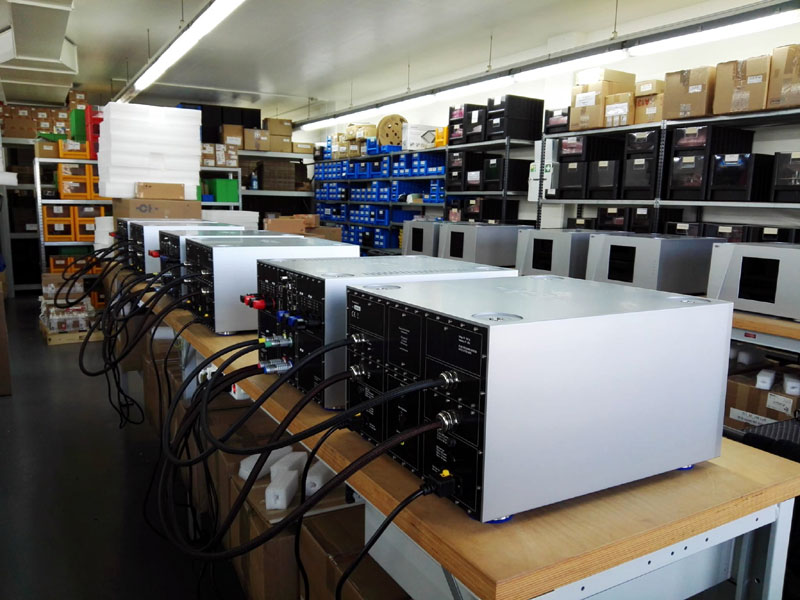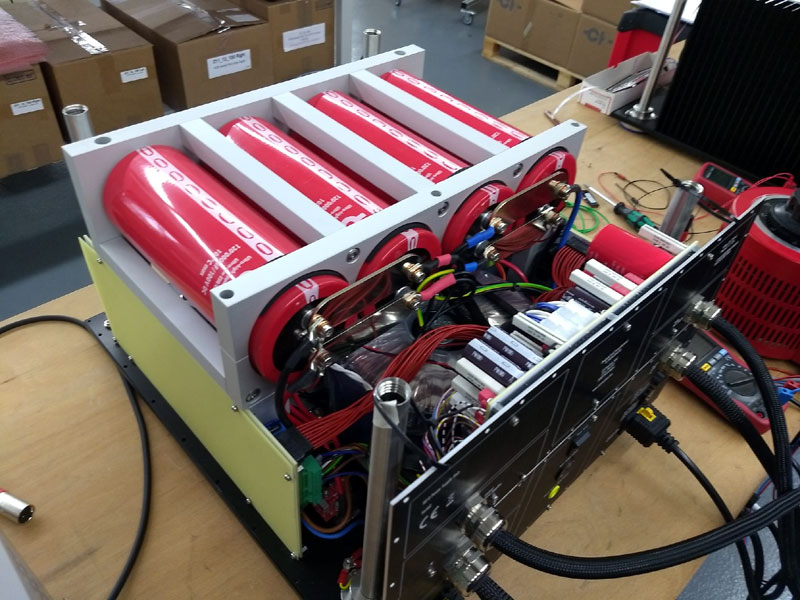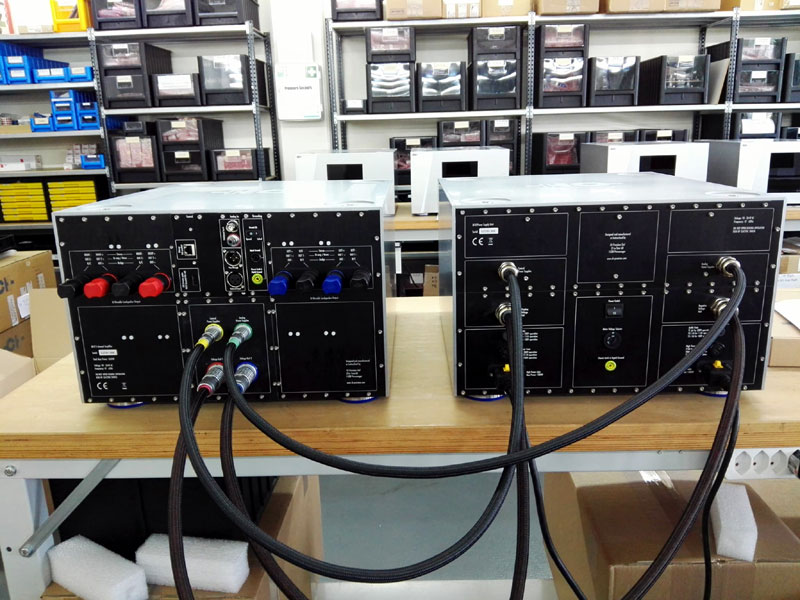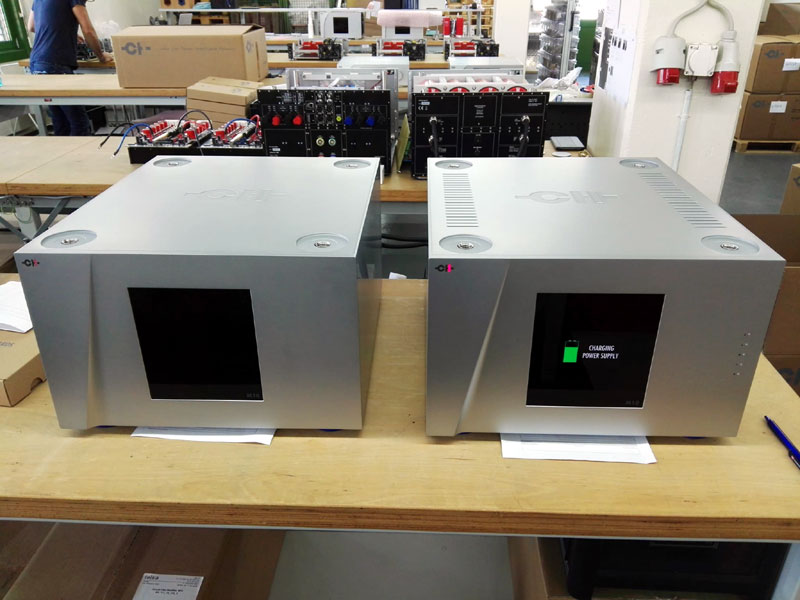A New Dawn? Early Impressions of the CH Precision L10 Preamp and M10
Amplifier
hile CH Precision’s long-awaited 10 Series electronics have finally arrived, delayed due to COVID-19’s impact on the supply chain, the virus has also disrupted efforts to offer a proper launch platform. Rarely have products promising such exceptional performance crept so quietly onto the world stage. With CH Precision’s offices and manufacturing facility being the next best thing to local (well, as local as you can get with an international border in the way), I’ve been treated to a couple of pre-launch listening sessions with both the L10 ($73,000) and M10 ($93,000), experiences that have only heightened my rampant sense of anticipation. So when the company invited me to visit and hear the production units, I was in the car before they’d put the phone down. The other (rather more positive) impact of COVID is that on arrival, the company simply turned over its listening room, allowing me unsupervised and unimpeded access, not least because it was all hands on deck to build and test 10 Series product. So I was left alone with an L10 and M10, but also the established L1 and M1.1 models too, free to mix, match and ring the changes for as long as I wished. For once, an “away fixture” actually stood a serious chance of delivering meaningful results. But before we get to the sonic and musical details, I should probably set the scene. For anybody wondering, the L10 and M10 are not replacements for the existing L1/M1.1 models. The 1 Series will continue as before -- and, I suspect, continue to enjoy its benchmark status -- the L10/M10 combination representing the first models in the 10 Series, positioned well above the 1 Series units. How far above? In price terms, at $73,000 for the L10, it’s a 40% increase on the equivalent L1/X1 ($51,500), while the $93,000 for the M10 is a 60% hike on the cost of an M1.1. So there should be no confusing the two lines. To further differentiate them, both the L10 and M10 are twin-chassis designs, each coming with its own, dedicated external power supply. Unlike the 1 Series, that second box for the L10 isn’t an option but comes as standard, while in the case of the M10 it’s more of a necessity. With the amp having half as much again power as the M1.1, two massive mains transformers and twice the reservoir capacitance, building the entire M10 into a single chassis would have created an almost immovable object. As it is the amplifier chassis weighs in at over 120 pounds, with the power supply adding another 190. Despite the two-box format, the M10 is a stereo amplifier, although being a CH Precision design it can also be user-configured for biamp, bridged or high-current mono operation. Otherwise the two 10 Series units are operationally almost identical to their 1 Series brethren -- making them amongst the most versatile and configurable products on the market.
The one really big operational difference lies in the global-feedback arrangements, with the user given a choice of local or global feedback in the L10 and user selectable global feedback ratio/damping factor in the M10, tunable between 0 and 100% in 1% steps. So the first order of business was to dial in the preferred option/values for the system at hand. I played a range of classical pieces, and there was no question that a combination of local feedback on the L10 and just a touch of global feedback on the M10 allowed the music to breathe, bringing greater expressive range and a more engaging performance. But swapping to rock or electronica, switching the L10 to global feedback added pace, momentum and dynamic impact to the music. Steve Earle’s Copperhead Road [Geffen/Universal 06 02517 65898] is as grungy as it is packed full of musical brilliance and recalcitrant attitude. Running with global feedback added weight, purpose and some necessary intent to the title track, yet also conjured a more immediate and communicative quality from the soulful "Even When I’m Blue." It’s another example of the dangers and limitations inherent in the sort of one-size-fits-all dogma so prevalent in audio design -- and the genuine musical benefits available from careful consideration of the finer points of setup and system tuning, especially when those points are so easily adjustable.
With that settled, it was time for a few direct comparisons, starting with the L1/X1 and L10. That there were clearly audible differences should come as no surprise, but what was genuinely shocking was the scale and musical significance of those differences, underlining once again the crucial role of the line stage in the system as a whole. In this regard, the L1 is amongst the rarest of audio beasts, a line stage that effectively anchors the system, bringing a planted sense of power and authority to musical proceedings but doing so without apparently limiting the expressive range or vitality in the performance. It’s a unit that I can -- and have -- happily lived with and enjoyed, all whilst barely noticing its presence. Yet the superiority of the L10 was -- to quote the old cliché -- clear from the first note. In fact, it was clear from before the first note, in the quality, expanse and definition of the recording’s acoustic space. As the microphones came up on the Walter Leigh Harpsichord Concertino [Lyrita SRCD.289], the L10 generated a far more clearly defined acoustic space, one that was significantly deeper, broader and taller, with more apparent boundaries and an audible floor. But what was actually more impressive was the fact that the quality of the air within the acoustic, the character and spectral balance of the original venue, was rendered distinct from the listening room and reached forward to include the listening seat. It’s suggestive of greater resolution, a much lower noise floor and lower levels of coloration, all of which were confirmed as soon as the music started. The L10 also brought greater presence, dimensionality and spatial organization, the location, spacing and relative size of different instruments becoming far more natural, along with the overall stereo perspective. The listener’s relationship to the performance was more clearly defined, but so too was the performance itself, with more articulate playing and significantly more lucid phrasing, this latter quality perhaps the most telling of all. Along with more definite dynamics and placement of notes, this suggests a significant step forward in temporal coherence. It definitely delivers a more convincing, immediate, engaging and immersive experience. Moving on to the young Martha Argerich’s seminal recording of the Prokofiev Piano Concerto No.3 (with Abbado and the BPO [Deutsche Grammophon Gesellschaft/UHQCD UCCG-40086]), once again the sense of space and orchestral spread, the location and focused concentration of the energy generated by individual instruments (be that the plaintive opening winds or the explosive solo piano) were as natural as they were impressive. The relative weight and attack of Argerich’s notes was effortlessly apparent, as convincing as the size, weight and complexity of her instrument. Yet the thing that really impressed was the facility with which these qualities were bound into the performance as a whole. It was all too easy to understand just why Argerich exploded into the classical consciousness like a hand grenade tossed into the reading room of a gentleman’s club. The vivid colors and drama in her playing were as crisp and clear as the individual notes, the range, impact and contrasting delicacy in those cascading tumbling phrases, fractured structures and stentorian detonations. Combined with Abbado’s deft direction and the BPO’s flawless playing, the result on the L10 is a musical tour de force, but what is really impressive is that it’s the music and the playing that impresses, rather than the sonics of the reproduction.
Throw the M10 into the mix and that expressive range becomes wider still, the grace and fluidity of lines, the unimpeded sense of musical flow and human agency making the usually impressive M1.1 sound stilted and hesitant in comparison. It’s not just the ease and precision with which the bigger amp tracks dynamic demands, it’s the absolutely planted stability that it brings to images and instruments, built out of the increased low-frequency transparency that the L10/M10 deliver. Together, they don’t just provide more energy, it’s the quality of the energy -- or more particularly, the way they energize the air within the listening room -- that is so different and so much more natural. The way that energy arrives is uncannily reminiscent of the way you feel and hear energy coming off of a live orchestra on stage. The Lisa Batiashvili recording of the Shostakovich Violin Concerto (Echoes of Time [Deutsche Grammophon Gesellschaft 477 9299]) proved to be the perfect case in point. This is not the greatest recording, but both Batiashvili and Salonen directing the SBR turn in stellar performances. The M1.1 has plenty of weight and power, presence and poise, but the M10 lifts things to another level. Where the M1.1 tracks dynamic levels with a wonderful precision, the added color and layering, the musical fluency of the M10 allows it to trace the emotional intensity in Batiashvili’s playing, the thing that makes this performance so remarkable. Of course, a lot of that effortless flow emanates from the output sockets of the L10, but the M10 still has to pass that signal intact, something it does with a grace and ease that belie its monstrous power output -- right up until you need it. When someone hits a timpani, the M10 responds with alacrity, while the deep gurglings that so often muddy the bottom end of audio systems are resolved not just in pitch and purpose, but texture too, whether plucked, bowed, amplified or acoustic.
With no oversight, I was also able to investigate the performance of the L10 in comparison to the former flagship model, the physically and musically impressive L1 four-box, a combination which (at $92,000) costs significantly more than the new pretender. The four-chassis setup immediately imposed its familiar sense of space, stability, weight and power, but once again, the sinuous fluency, the deft way with a musical line and the expressive range of the L10 left the four-box L1 sounding a shade heavy, stilted and clumsy -- which is not something I ever expected to write. That is both a reflection of just how high the 10 Series products have raised the musical bar and their potential impact on the carefully constructed CH Precision upgrade path. Still, from the company’s point of view, I’m guessing that’s a nice problem to have. Four-box L1 owners might be less sanguine, at least at first blush. But it won’t take long for them to realize that there’s the four-box L10 waiting in the wings, an option that should ensure the best of both worlds -- the weight and authority of the four-box L1 combined with the emotive and communicative performance of the L10. Meanwhile, I can see the same logic applying to the M1.1 to M10 upgrade. Is the M10 better than two M1.1s? Almost certainly -- but if you’ve got two M1.1s, you’ll be looking for two M10s to really realize the upgrade potential. This is not a review. It’s not even the start of a
review. What it is is a tantalizing first taste of just what these long-awaited
electronics can do. CH Precision's 1 Series has been and remains consistently impressive.
That doesn’t stop the 10 Series being streets ahead; it just makes its superiority
all the more remarkable. |




